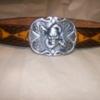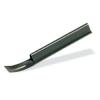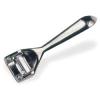-
Posts
1,018 -
Joined
-
Last visited
Content Type
Profiles
Forums
Events
Blogs
Gallery
Everything posted by TomG
-
I have a customer who wants me to stamp some 3D images into her Carhartt belt. Does anyone know what kind of leather they use? I’ve looked at a few at the local Northern Tool and saw several models. Some are lined and say Italian Leather. Some look like the flesh side is either glued smooth or burnished smooth and saw Genuine Leather. Anyone know anything about them? Thanks
-
Tandy has some videos on their site showing how to set snaps and you can see the circular motion Chief mentioned. Also, look into a tool called a Press-N-Snap. I've heard nothing but good about it. You can also search here for a couple of good links to how to convert a $50 1-ton arbor press into a leather press.
-
Like Rivercity said - Thin the hell out of it. This is true with almost ALL Fiebings dyes. Use small containers that you can close up tight. I usually start with 75% alcohol to 25% dye. Take a strip of leather, write the dilution down on the back and dye that short section. If it's too light, add some dye. Write on the back - test dye. Be sure to let it dry well before deciding how the color looks. Be sure to use a fresh applicator for each test. And as always, the particular piece of leather will determine the exact final color. You can use a syringe to make the small batches to test. I've even taken medium brown, broken it up into 3 or 4 bottles of various strengths and just made my own "true" colors. I get light brown, medium brown and dark brown at the very least. Goodluck
-
I got a couple of tolls from our of our folks here and we are trying to figure out exactly what 2 of them are. I know they are copper rivet setters, but not sure what size and the brand on one of them. One looks like a Tandy item. Marked Taiwan. I THINK it's a #9, but all I have are #12 rivets. The second (larger one) looks like maybe for a #12, but I'm new to copper rivets so I don't know for sure. I did have some issues with getting a good rounding on the end when I tried it. It is pretty heavy and is only marked with a "C" on one side and 2 "C"'s on the other. Any info is appreciated. Thanks
-
How about wet forming a channel down the scabbard with a square dowel rod. Tom
-
I've used a number of things to apply the 50/50 res. What I like best is an old cotton shirt - not a tee shirt but a dress shirt type material. I used a small square folded in half. I put it on the edge of the bottle, tip the juice onto the cloth. Then I strike a quick stroke on my newsprint that I use to see how much I'll be laying down and then wipe the surface of the leather. Works perfect. Lays down a microthin layer. What area of the country do you live in?
-
Must be thinking of a different thread. No problem with the tag. Tom
-
Oh boy -- "...Forest for the trees...". I don't think anyone mentioned this, did they? I think you said you were a woodworker (unless I'm confused, which is totally possible). An edger cuts the edges off the top and bottom edges of the strap. Like rounding a square wood blank before turning it on a lathe. Makes burnishing a WHOLE lot easier!.. Tom
-
2 things - Dying - LOTS of info under that specific subheading. But in a nutshell, you can try some dark blue under the black. Use Fiebings oil dye or equiv. I use either dip dye or a wool dauber to apply my dyes. For the gluing, you might try dry fitting the top over the bottom and using sharp pencil/mechanical pencil to trace the outlines of the letters on the inside of the liner piece. Then use a small brush to apply the glue to it so you don't get glue inside of the letters on the lining piece.
-

Major Cracks...
TomG replied to PirateWolf's topic in Dyes, Antiques, Stains, Glues, Waxes, Finishes and Conditioners.
You use a skiver. Tandy has a couple and other suppliers do as well. Usually around $15 or so. As you get more involved, you might invest in a leather splitter. But then you're talking $300 and up unless you can find a good one used. they key word being "good". Here's photos of the 2 from Tandy... -

Major Cracks...
TomG replied to PirateWolf's topic in Dyes, Antiques, Stains, Glues, Waxes, Finishes and Conditioners.
Based on the photo and looking at the holes, I'd say that 1 - the leather is too thick at the bend. That's more than the finish cracking. So - you need to skive it down about 50% thickness from before the bend to the tip. 2 - Wet the back of the leather and let it sit for a few minutes to soak in before you bend it. And like RiverCity said, let the thing dry after bending and then put your finish on. -
If you're making any type of dog collars, belts or other strap items, a strap cutter is the way to go. I do have a 6 foot long piece of cold roll steel I picked up that I use to make the my edge on a new side straight before I strap cut it. For my lined belts and collars, I cut a full-length strap, use a splitter to make it the same thickness from end-to-end. Glue them together. You have to develop a touch to make sure the edges are perfectly lined up when you put the glued faces together, but practice makes perfect. Or, you can do what cyberthrasher said, and make one bigger than the other and trim. I always seem to screw up the edges when I try that though.. I always seem to forget to put pressure on my straight edge and the leather moves under it as I cut. One trick I've used for the lined collars is to apply the contact cement and let it set. set one strap on its edge on my slab. Carefully line up the 2 ends and stick them together, then slowly join the resat of the strap, working from that end. The slab helps to line the edges up perfectly. Any slight variations go away with some sanding.
-
So, for the sharpest edge, what angle is considered the best angle for a head knife? And -- What is the difference between a head knife and a round knife?
-
Not sure how the MOP will work after gluing and stitching, but I'd play with some test pieces to see. The paste will darken the leather depending on the leather and how much you use. I wonder what would happen if you did the treatment to both backs, and sewed them together without the glue?
-
I make belts, bracelets and dog collars/leashes. Most are not lined, but I treat them with a Kiwi Camp Dry Mink Oil Paste. I rub a small amount into the length of the strap on the back and then run the strap through my hands in a curved motion 2 or 3 times from the front and then from the back. Makes most of them limp and soft as spaghetti. But if you glue your liners in, I doubt it would stick to the oiled backs of the straps. But, I could be wrong. You can always try it and see. Tom
-

220V Ez Clutch Motor Woes- Troubleshooting Help?
TomG replied to MCM Ranch's topic in Sewing Leather
The key is still that "3 Phase" you mentioned. You can not run a 3 Phase motor on standard Single Phase 220 voltage that 99.9% of households have. 3 Phase is a commercial voltage and is only avaiable special order You can buy a convertor to make it work but last time I checked they were $400 - $500. Tom -

220V Ez Clutch Motor Woes- Troubleshooting Help?
TomG replied to MCM Ranch's topic in Sewing Leather
You said it has a 3 phase motor. Silly question, but do youi have 3 phase service to you shop? Tom -
A coworker was surfing through Craiglist the other day and came across someone locally giving away 2 PALLETS of what was described as PIG SKIN LEATHER. I called the lady and she said it was raw and untanned. It was in a storage locker. I asked her if it stunk, and she said it was beginning to. She also said it was wet. Does anyone have any idea of what reason someone would have to store untanned pig skin in a storage locker for? It's a little too far a way to just shoot over and take a look at. but I AM curious. They had a picture but it looks like they took the listing down <g> Thanks
-
I'm looking for a rugged and water resistant leather for making belts or collars. I know Latigo will fit the bill. But's it usually only comes in burgundy, and black - although IO think I saw some other colors somewhere. I'm wondering how the Stoned oil or Drum Dyed leather like they are advertising on Tandy would hold up. Some of it is 8/9 oz, and I can line 6/7 if need be. Or double it up. It needs to be strong and pliable, with minimal stretch. Suggestions? I'm using vegtan now, but just looking for a different look and feel for some deluxe type products. Thanks
-

Box Pocket--How To Neatly Trim Excess Leather Flaps?
TomG replied to thekid77's topic in How Do I Do That?
I looked back at the wet formed bag tutorial and see what you mean. I would assume that using nails to hold the leather over the form would not be the preferred method if you were going to machine sew the bag together, right? I don't see how you'd get the stitch line close enough to cover the nail holes. -

Box Pocket--How To Neatly Trim Excess Leather Flaps?
TomG replied to thekid77's topic in How Do I Do That?
If you use the technique of nailing it down over a box, what do you do to hide the nail holes? -
I agree with northmount... and add All The Above. I do a lot of stamping on 3/4 oz veg-tan. I find that I get MUCH better impressions by doing 2 things. 1) I stamp with my casing SLIGHTLY wetter than normal - don't let it get quite as dry as normal 2) I put a piece of scrap 8-10 oz under the piece I'm stamping. try pressing down on the stamp and tapping it a bit lighter or use a light maul or mallet. You can make multiple hits on a stamp as long as you don't let the stamp bounce.







